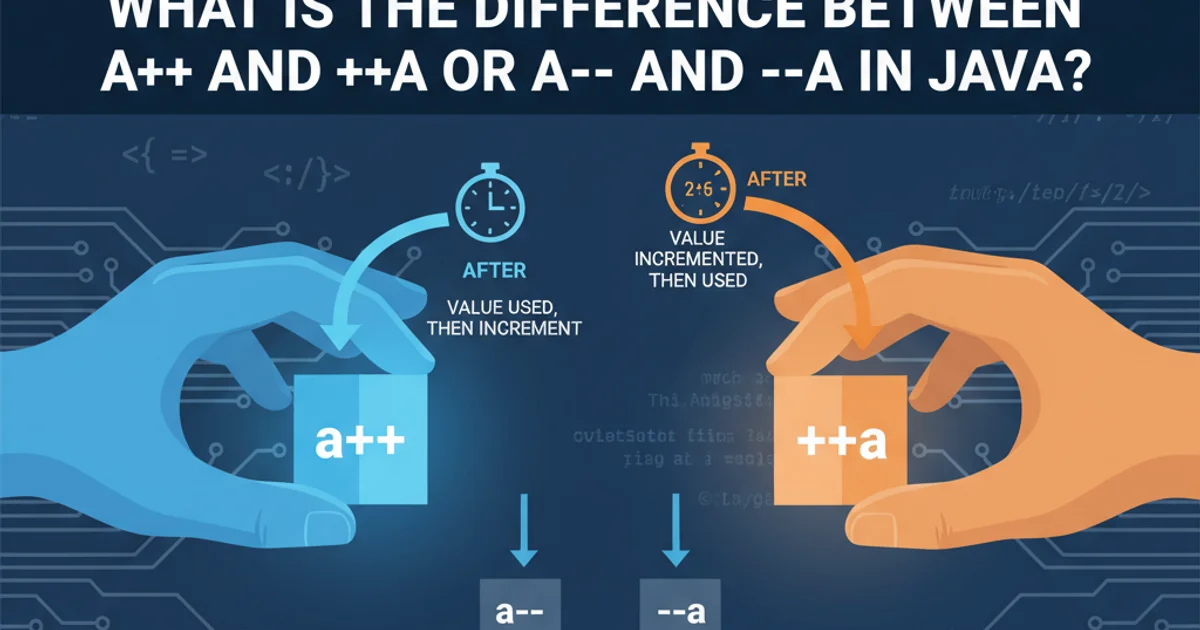what is the difference between a++ and ++a or a-- and --a in java?
Categories:
Understanding Pre-increment/decrement (a++) vs. Post-increment/decrement (++a) in Java

Explore the crucial differences between pre-increment/decrement (++a, --a) and post-increment/decrement (a++, a--) operators in Java, and how they affect variable values in expressions.
In Java, increment (++) and decrement (--) operators are unary operators used to increase or decrease the value of a variable by one. While they both modify the variable's value, their behavior differs significantly when used within an expression. This article will break down the mechanics of pre-increment/decrement and post-increment/decrement, providing clear examples and a visual representation to solidify your understanding.
The Basics: Increment and Decrement Operators
Before diving into the 'pre' and 'post' distinctions, let's quickly review what these operators do. The ++ operator adds 1 to its operand, and the -- operator subtracts 1 from its operand. They are shorthand for a = a + 1 and a = a - 1 respectively.
int a = 5;
a++; // a becomes 6
--a; // a becomes 5
Basic usage of increment and decrement operators.
Post-increment (a++) and Post-decrement (a--)
The 'post' versions of these operators (a++ and a--) mean that the original value of the variable is used in the expression first, and then the variable's value is incremented or decremented. Think of it as 'use then change'.
int a = 5;
int b = a++; // b gets the original value of a (5), then a becomes 6
System.out.println("a: " + a); // Output: a: 6
System.out.println("b: " + b); // Output: b: 5
int x = 10;
int y = x--; // y gets the original value of x (10), then x becomes 9
System.out.println("x: " + x); // Output: x: 9
System.out.println("y: " + y); // Output: y: 10
Example demonstrating post-increment and post-decrement.
Pre-increment (++a) and Pre-decrement (--a)
Conversely, the 'pre' versions (++a and --a) mean that the variable's value is incremented or decremented first, and then the new value is used in the expression. Think of it as 'change then use'.
int a = 5;
int b = ++a; // a becomes 6, then b gets the new value of a (6)
System.out.println("a: " + a); // Output: a: 6
System.out.println("b: " + b); // Output: b: 6
int x = 10;
int y = --x; // x becomes 9, then y gets the new value of x (9)
System.out.println("x: " + x); // Output: x: 9
System.out.println("y: " + y); // Output: y: 9
Example demonstrating pre-increment and pre-decrement.
flowchart TD
subgraph Post-Increment (a++)
A[Start with 'a'] --> B{"Use 'a' in expression"}
B --> C["Increment 'a' by 1"]
C --> D[End]
end
subgraph Pre-Increment (++a)
E[Start with 'a'] --> F["Increment 'a' by 1"]
F --> G{"Use new 'a' in expression"}
G --> H[End]
endFlowchart illustrating the order of operations for pre- and post-increment.
a++; or ++a;), there is no practical difference in the final value of a. The distinction only matters when the operation is part of a larger expression where the value of a is also being used.Common Pitfalls and Best Practices
While these operators are powerful, their subtle differences can lead to bugs if not understood properly. It's generally recommended to avoid using increment/decrement operators within complex expressions where their order of evaluation might be ambiguous or hard to read. For clarity, separate the increment/decrement operation from the expression where the value is used.
// Less readable and potentially confusing
int result = someFunction(a++) + anotherFunction(++b);
// More readable and less error-prone
int tempA = a;
a++;
int tempB = b;
b++;
int result = someFunction(tempA) + anotherFunction(tempB);
Comparing complex vs. clear usage of increment/decrement operators.